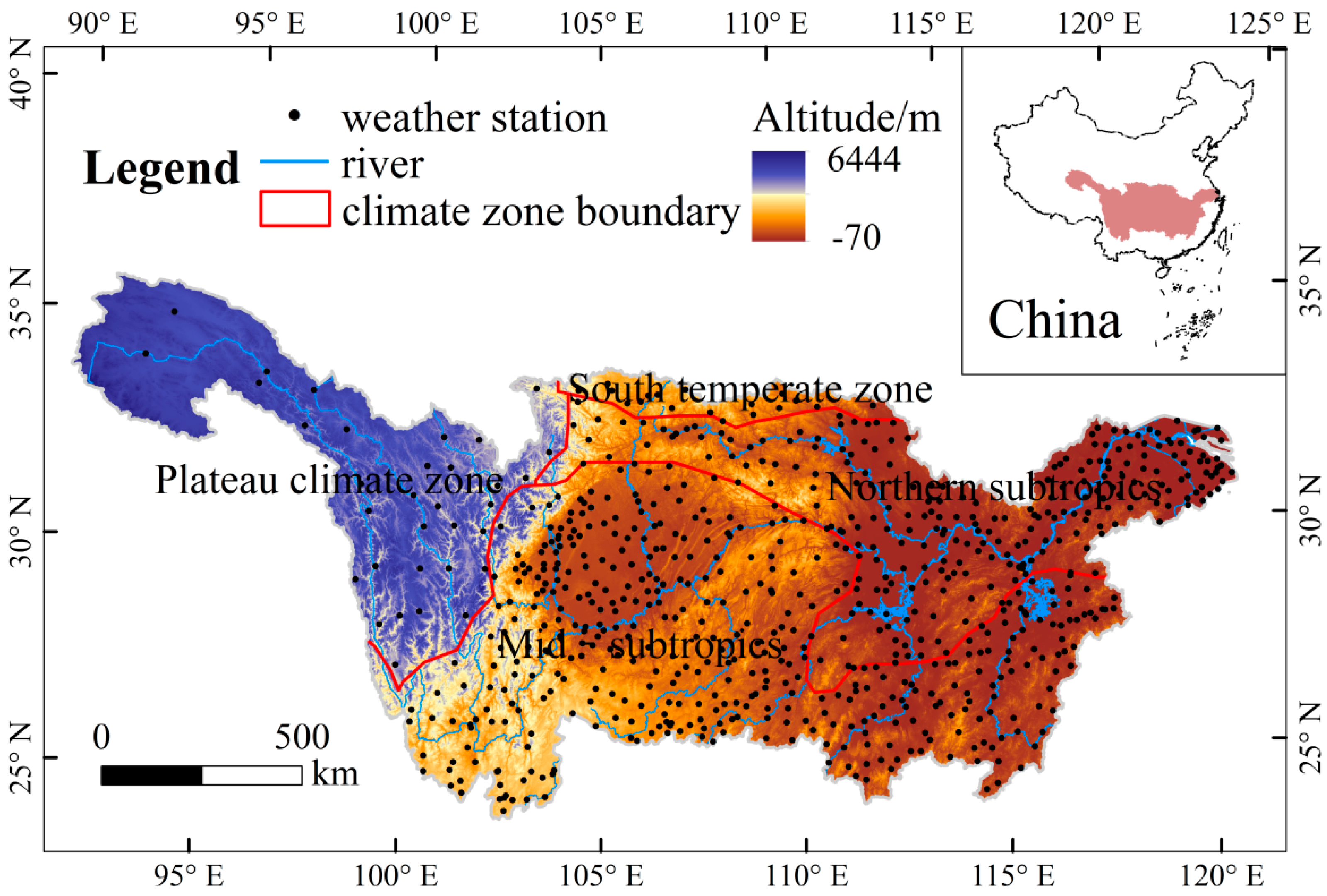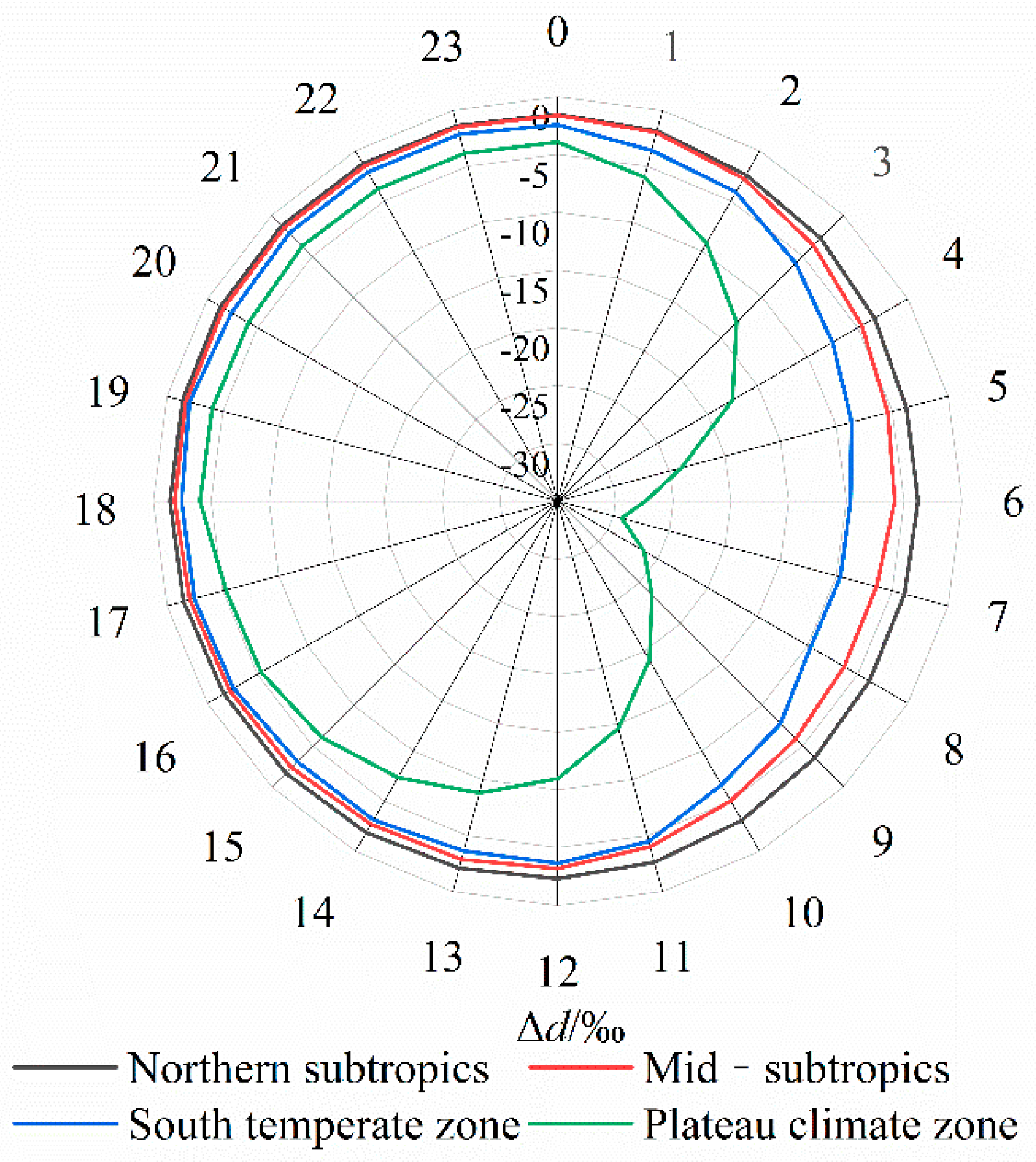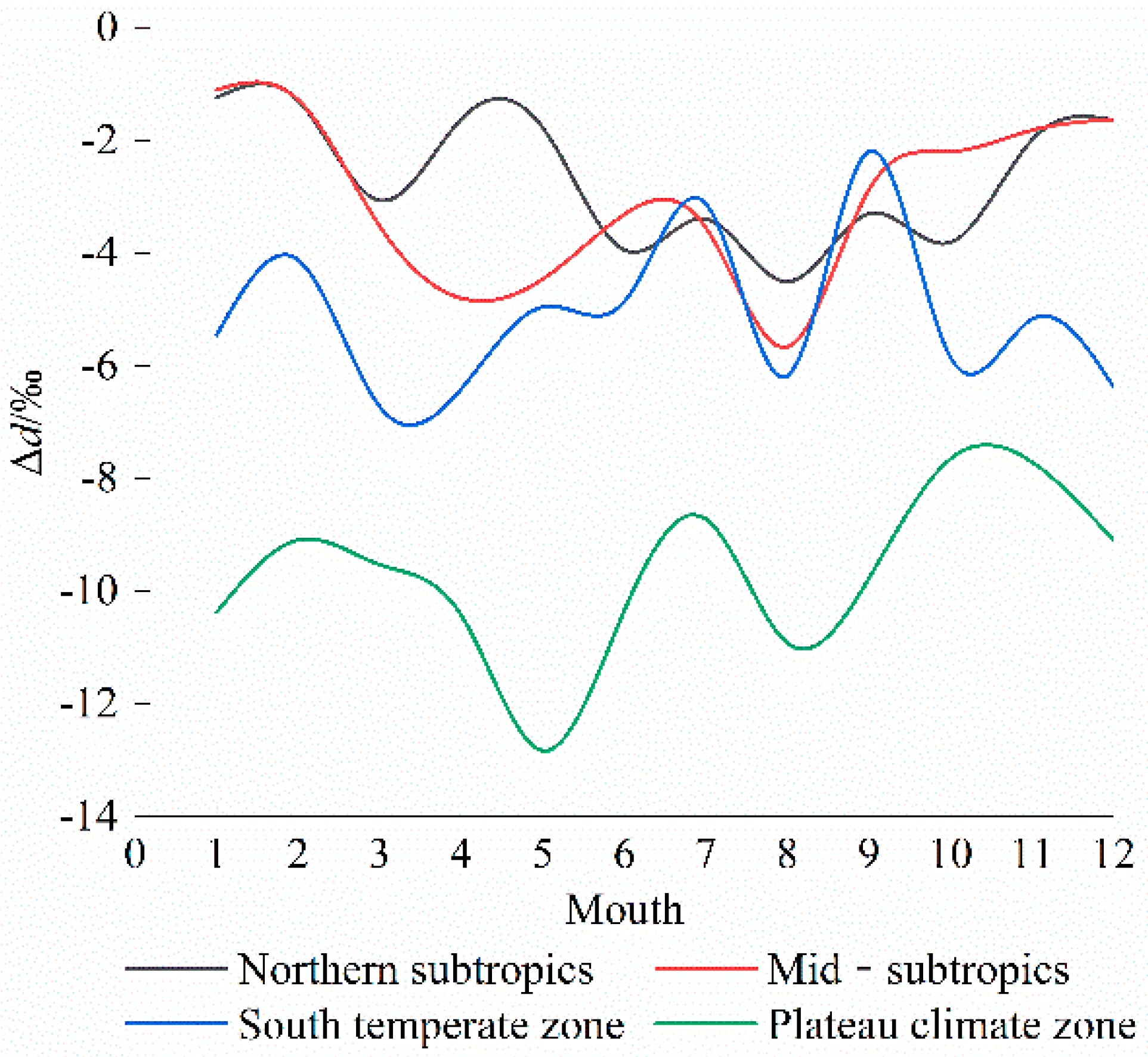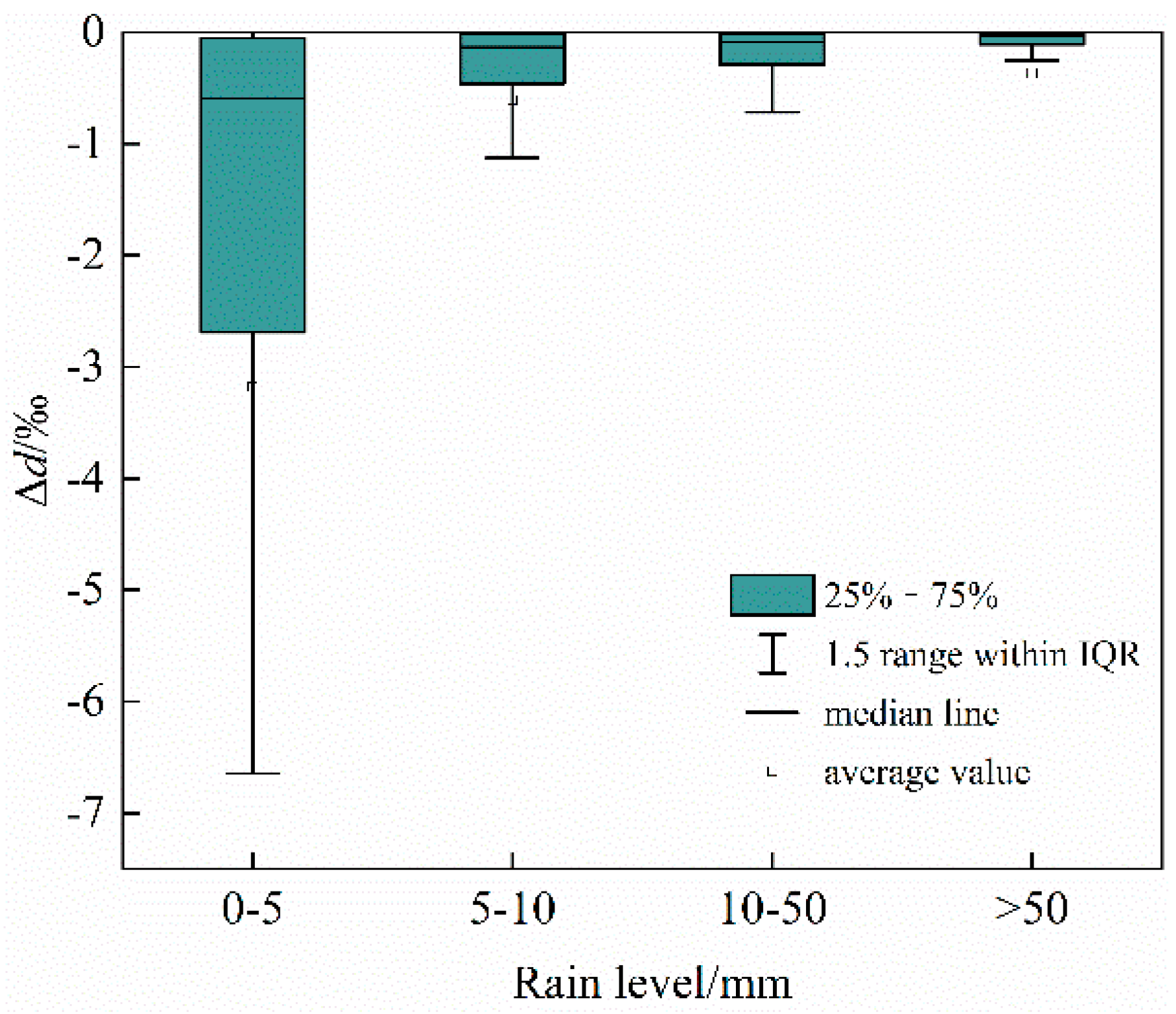Sub-Cloud Secondary Evaporation in Precipitation Stable Isotopes Based on the Stewart Model in Yangtze River Basin
Abstract
1. Introduction
2. Materials and Methods
2.1. Study Area
2.2. Data Sources
2.3. Methods
3. Results
3.1. Temporal Variation of Precipitation Deuterium Excess (Δd)
3.1.1. Δd Hourly Changes
3.1.2. Δd Monthly Changes
3.2. Spatial Variation of Precipitation Excess Deuterium Variation (Δd)
3.3. The Relationship between Precipitation Deuterium Excess Variation (Δd) and Influence Factors
4. Discussion
5. Conclusions
- (1)
- As far as the hourly variation is concerned, the Δd value of the whole Yangtze River Basin is smaller in the daytime than at night. As far as the monthly variation is concerned, the northern subtropics and the south temperate zone are more consistent: the Δd value is smaller in summer and autumn. The mid-subtropics and plateau climate zones have lower Δd values in spring and summer.
- (2)
- The spatial variation of Δd value in different seasons of the Yangtze River Basin is significant. The annual Δd value in the plateau climate zone is smaller than that in other areas, while the winter Δd value in the plateau climate zone is larger than that in other seasons.
- (3)
- The influence factors of different magnitudes have obvious differences in the sub-cloud secondary evaporation. When the rainfall is 0–5 mm, the average value of Δd is the smallest, and with the increase of rainfall, the average value of Δd decreases regularly. When the temperature is greater than 30 °C, the value of Δd decreases rapidly to the minimum, compared to when the temperature is 20–30 °C. The higher the temperature, the more significant the sub-cloud secondary evaporation. When the vapor pressure is less than 3 hPa, the Δd value is the smallest. As the vapor pressure increases, the Δd value continues to increase; when the relative humidity is 50–60%, the Δd value is the smallest. When the raindrop diameter is 0.5–1 mm, the value of Δd is the smallest. With the increase of raindrop diameter, the value of Δd is increasing, and there is an obvious positive correlation between them.
Supplementary Materials
Author Contributions
Funding
Institutional Review Board Statement
Informed Consent Statement
Data Availability Statement
Acknowledgments
Conflicts of Interest
References
- Brunel, J.P.; Walker, G.R.; Dighton, J.C. Use of stable isotopes of water to determine the origin of water used by the vegetation and to partition evapotranspiration. A case study from HAPEX-Sahel. J. Hydrol. 1997, 188, 466–481. [Google Scholar] [CrossRef]
- Wu, X.; Zhu, X.; Pan, M. Seasonal variability of oxygen and hydrogen stable isotopes in precipitation and cave drip water at Guilin, southwest China. Environ. Earth Sci. 2014, 72, 3183–3191. [Google Scholar] [CrossRef]
- Masson-Delmotte, V.; Jouzel, J.; Landais, A. GRIP deuterium excess reveals rapid and orbital-scale changes in Greenland moisture origin. Science 2005, 309, 118–121. [Google Scholar] [CrossRef]
- Aemisegger, F.; Pfahl, S.; Sodemann, H. Deuterium excess as a proxy for continental moisture recycling and plant transpiration. Atmos. Chem. Phys. 2014, 14, 4029–4054. [Google Scholar] [CrossRef]
- Merz, N.; Gfeller, G.; Born, A. Influence of ice sheet topography on Greenland precipitation during the Eemian interglacial. J. Geophys. Res. Atmos. 2014, 119, 10749–10768. [Google Scholar] [CrossRef]
- Dudgeon, D.; Arthington, A.H.; Gessner, M.O. Freshwater biodiversity: Importance, threats, status and conservation challenges. Biol. Rev. 2006, 81, 163–182. [Google Scholar] [CrossRef]
- Dansgaard, W. The abundance of 18O in atmospheric water and water vapor. Tellus 1953, 5, 461–469. [Google Scholar] [CrossRef]
- Dansgaard, W. Stable isotopes in precipitation. Tellus 1964, 16, 436–468. [Google Scholar] [CrossRef]
- Craig, H. Isotopic variations in meteoric waters. Science 1961, 133, 1702–1703. [Google Scholar] [CrossRef]
- Froehlich, K.; Kralik, M.; Papesch, W. Deuterium excess in precipitation of Alpine regions: Moisture recycling. Isot. Environ. Health Stud. 2008, 44, 61–70. [Google Scholar] [CrossRef] [PubMed]
- Kress, A.; Saurer, M.; Siegwolf, R.T.W. A 350 year drought reconstruction from Alpine tree ring stable isotpes. Glob. Biogeochem. Cycles 2010, 24, GB2011. [Google Scholar] [CrossRef]
- Steen-Larsen, H.C.; Masson-Delmotte, V.; Sjolte, J. Understanding the climatic signal in the water stable isotope records from the NEEM shallow firn/ice cores in northwest Greenland. J. Geophys. Res. 2011, 116, D06108. [Google Scholar] [CrossRef]
- Stewart, M.K. Stable isotope fractionation due to evaporation and isotopic exchange of falling waterdrops: Applications to atmospheric processes and evaporation of lakes. J. Geophys. Res. 1975, 80, 1133–1147. [Google Scholar] [CrossRef]
- Peng, T.; Wang, C.H.; Huang, C. Stable isotopic characteristic of Taiwan’s precipitation: A case study of western Pacific monsoon region. Earth Planet. Sci. Lett. 2010, 289, 357–366. [Google Scholar] [CrossRef]
- Salamalikis, V.; Argiriou, A.A.; Dotsikae, E. Isotopic modeling of the sub-cloud evaporation effect in precipitation. Sci. Total Environ. 2016, 544, 1059–1072. [Google Scholar] [CrossRef] [PubMed]
- Wang, S.J.; Zhang, M.J.; Che, Y. Influence of below-cloud evaporation on deuterium excess in precipitation of arid central Asia and its meteorological controls. J. Hydrometeorol. 2016, 17, 1973–1984. [Google Scholar] [CrossRef]
- Crawford, J.; Hollins, S.E.; Meredith, K.T. Precipitation stable isotope variability and sub-cloud evaporation processes in a semiarid region. Hydrol. Process. 2017, 31, 20–34. [Google Scholar] [CrossRef]
- Ma, Q.; Zhang, M.J.; Wang, S.J. An investigation of moisture sources and secondary evaporation in Lanzhou, Northwest China. Environ. Earth Sci. 2014, 71, 3375–3385. [Google Scholar] [CrossRef]
- Kong, Y.L.; Pang, Z.H.; Froehlich, K. Quantifying recycled moisture fraction in precipitation of an arid region using deuterium excess. Tellus B Chem. Phys. Meteorol. 2013, 65. [Google Scholar] [CrossRef]
- Zhou, S.E.; Zhang, M.J.; Wang, S.J. Sub-cloud secondary evaporation in summer precipitation isotope in Gansu, China. Mt. Res. 2019, 37, 808–817. [Google Scholar]
- Sun, T.T. Study on the Variable Characteristic of the Water Stable Isotopic Compositions in Yangtze River Basin; Hohai University: Nanjing, China, 2007. [Google Scholar]
- Wu, H.W.; Zhang, X.P.; Sun, G.L. Variations of Δ18O in precipitation and moisture sources in the Yangtze River Basin. J. Meteorol. Environ. 2011, 27, 7–12. [Google Scholar]
- Dong, X.F.; Deng, H.Y.; Zheng, X.M. Analysis of stable isotope characteristics and water vapor origins in atmospheric precipitation in the Yangtze River Basin. Environ. Sci. Technol. 2017, 40, 78–84. [Google Scholar]
- Zhou, Y.; Wu, H.W.; He, B. Temporal and spatial variation characteristics of Δ18O and Δd in Yangtze River water and their influencing factors. Resour. Environ. Yangtze Basin 2017, 26, 678–686. [Google Scholar]
- Meng, Y.C.; Liu, G.D. Effect of below-cloud secondary evaporation on the stable isotopes in precipitation over the Yangtze River basin. Adv. Water Sci. 2010, 21, 327–334. [Google Scholar]
- Guo, J.; Chen, H.; Xu, C.Y. Prediction of variability of precipitation in the Yangtze river basin under the climate change conditions based on Automated statistical downscaling. Stoch. Environ. Res. Risk Assess. 2012, 26, 157–176. [Google Scholar] [CrossRef]
- Zhu, B.H. Chinese Climate; Science Press: Beijing, China, 1962. [Google Scholar]
- Friedman, I.; O’Neil, J. Data of Geochemistry: Compilation of Stable Fractionation Factors of Geochemical Interest; US Government Printing Office: Washington, DC, USA, 1977.
- Craig, R. Principles of Stable Isotope Distribution; Oxford University: New York, NY, USA, 1999. [Google Scholar]
- Best, A.C. The size distribution of raindrops. Q. J. R. Meteorol. Soc. 1950, 76, 16–36. [Google Scholar] [CrossRef]
- Chen, F.L.; Zhang, M.J.; Wang, S.J. Relationship between sub-cloud secondary evaporation and stable isotope in precipitation of Lanzhou and surrounding area. Quat. Int. 2015, 380–381, 68–74. [Google Scholar] [CrossRef]
- Jin, X.G.; Zhang, M.J.; Wang, S.J. Effect of below-cloud secondary evaporation in precipitation over the Loess Plateau based on the stable isotopes of hydrogen and oxygen. Environ. Sci. 2015, 36, 1241–1248. [Google Scholar]
- Zhou, S.E.; Zhang, M.J.; Wang, S.J. A comparison of sub-cloud secondary evaporation effect of precipitation isotope in Xinjiang based on the Stewart model improvement scheme. J. Glaciol. Geocryol. 2019, 41, 304–315. [Google Scholar]
- Xiao, H.Y.; Zhang, M.J.; Wang, S.J. Sub-cloud secondary evaporation effect of precipitation isotope in Shaanxi-Gansu-Ningxia region, China. Chin. J. Appl. Ecol. 2020, 31, 3814–3822. [Google Scholar] [CrossRef]
- Wu, H.W.; Zhang, X.P.; Li, X.Y. Seasonal variations of deuterium and oxygen-18 isotopes and their response to moisture source for precipitation events in the subtropical monsoon region. Hydrol. Process. 2015, 29, 90–102. [Google Scholar] [CrossRef]





| Subregion | Spring | Summer | Autumn | Winter |
|---|---|---|---|---|
| Northern subtropics | −2.16‰ | −3.95‰ | −3.04‰ | −1.39‰ |
| Mid-subtropics | −4.26‰ | −4.18‰ | −2.29‰ | −1.34‰ |
| South temperature zone | −6.03‰ | −4.72‰ | −4.40‰ | −5.31‰ |
| Plateau climate zone | −10.93‰ | −9.99‰ | −8.37‰ | −9.52‰ |
| Influence Factor | Range of Variation | Δd/‰ |
|---|---|---|
| Temperature/°C | <0 | −2.50 |
| 0–5 | −1.36 | |
| 5–10 | −2.29 | |
| 10–20 | −3.10 | |
| 20–30 | −4.35 | |
| >30 | −24.18 | |
| Vapor pressure/hPa | <3 | −12.21 |
| 3–6 | −4.93 | |
| 6–9 | −2.43 | |
| 9–12 | −3.20 | |
| >12 | −3.30 | |
| Relative humidity/% | <50 | −20.78 |
| 50–60 | −26.57 | |
| 60–70 | −25.67 | |
| 70–80 | −18.73 | |
| 80–90 | −8.36 | |
| >90 | −0.94 | |
| Raindrop diameter/mm | 0.5–1 | −4.39 |
| 1–1.5 | −1.36 | |
| >1.5 | −0.71 |
Publisher’s Note: MDPI stays neutral with regard to jurisdictional claims in published maps and institutional affiliations. |
© 2021 by the authors. Licensee MDPI, Basel, Switzerland. This article is an open access article distributed under the terms and conditions of the Creative Commons Attribution (CC BY) license (https://creativecommons.org/licenses/by/4.0/).
Share and Cite
Xiao, H.; Zhang, M.; Zhang, Y.; Huang, Z.; Yao, X.; Wang, J.; Han, T.; Su, P. Sub-Cloud Secondary Evaporation in Precipitation Stable Isotopes Based on the Stewart Model in Yangtze River Basin. Atmosphere 2021, 12, 575. https://doi.org/10.3390/atmos12050575
Xiao H, Zhang M, Zhang Y, Huang Z, Yao X, Wang J, Han T, Su P. Sub-Cloud Secondary Evaporation in Precipitation Stable Isotopes Based on the Stewart Model in Yangtze River Basin. Atmosphere. 2021; 12(5):575. https://doi.org/10.3390/atmos12050575
Chicago/Turabian StyleXiao, Hanyu, Mingjun Zhang, Yu Zhang, Zhihua Huang, Xuyang Yao, Jiaxin Wang, Tingting Han, and Pengyan Su. 2021. "Sub-Cloud Secondary Evaporation in Precipitation Stable Isotopes Based on the Stewart Model in Yangtze River Basin" Atmosphere 12, no. 5: 575. https://doi.org/10.3390/atmos12050575
APA StyleXiao, H., Zhang, M., Zhang, Y., Huang, Z., Yao, X., Wang, J., Han, T., & Su, P. (2021). Sub-Cloud Secondary Evaporation in Precipitation Stable Isotopes Based on the Stewart Model in Yangtze River Basin. Atmosphere, 12(5), 575. https://doi.org/10.3390/atmos12050575





